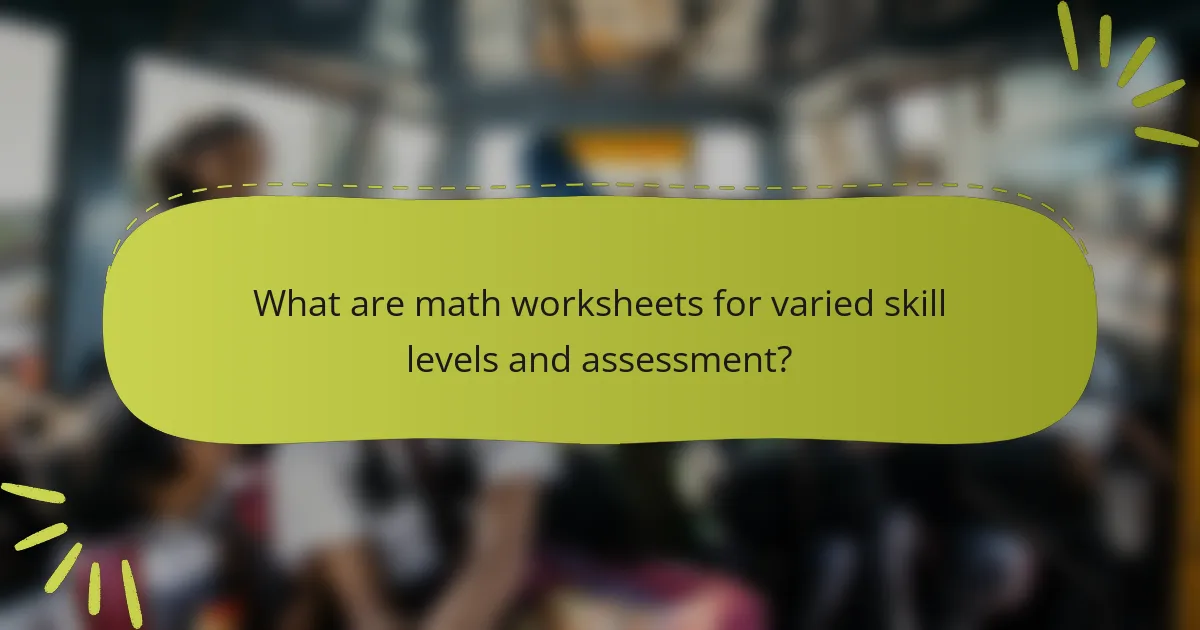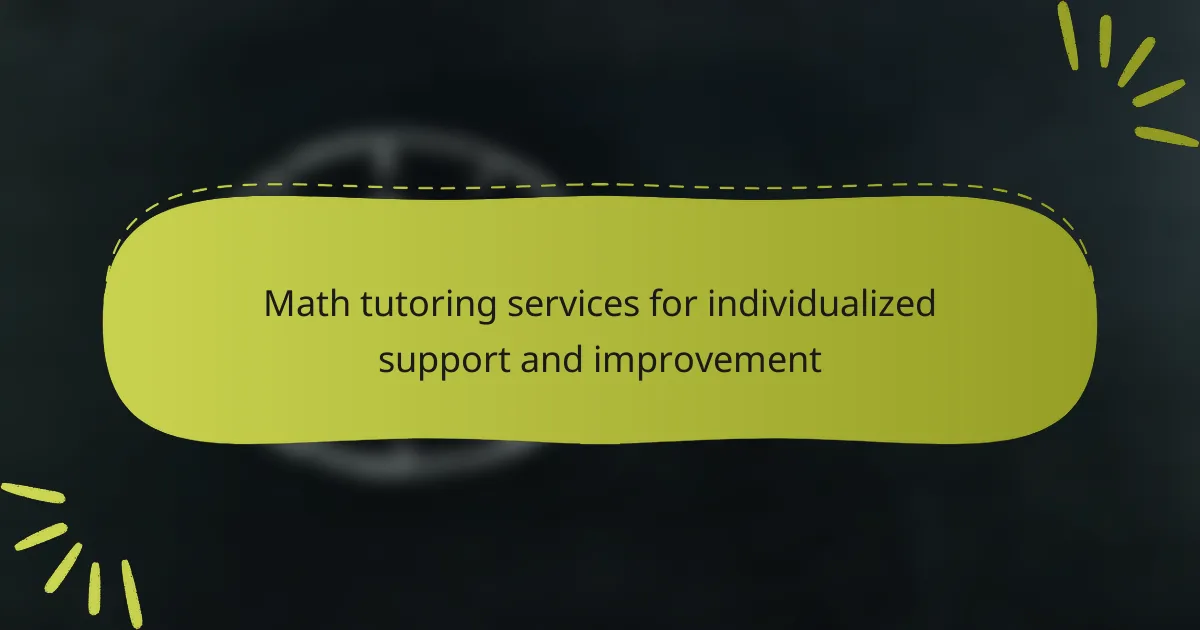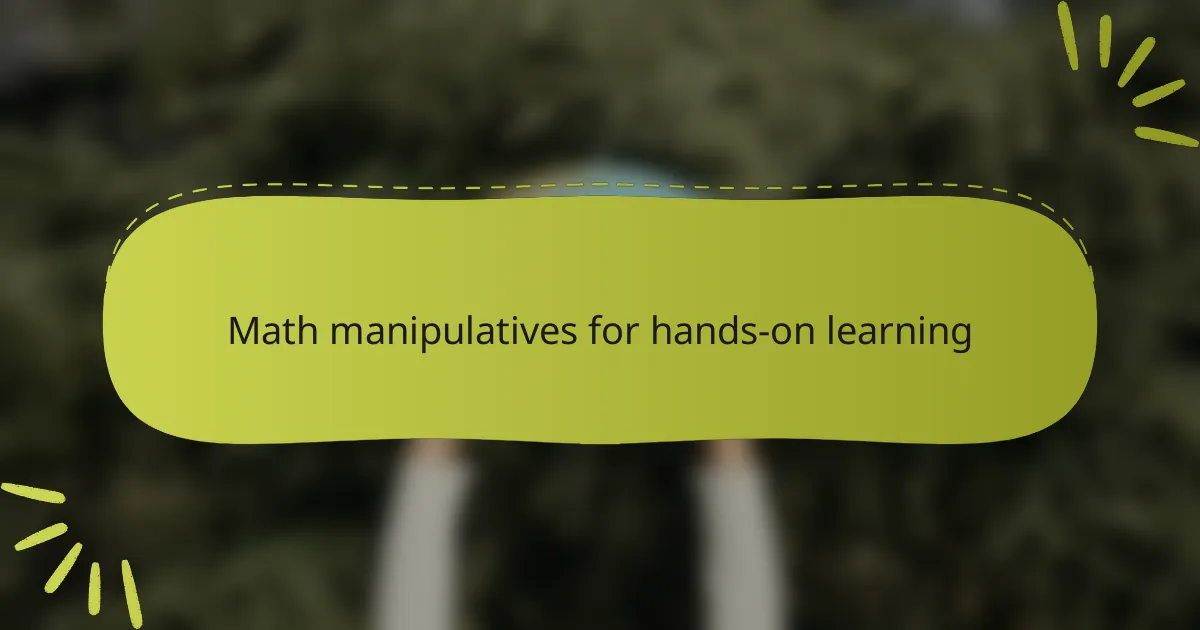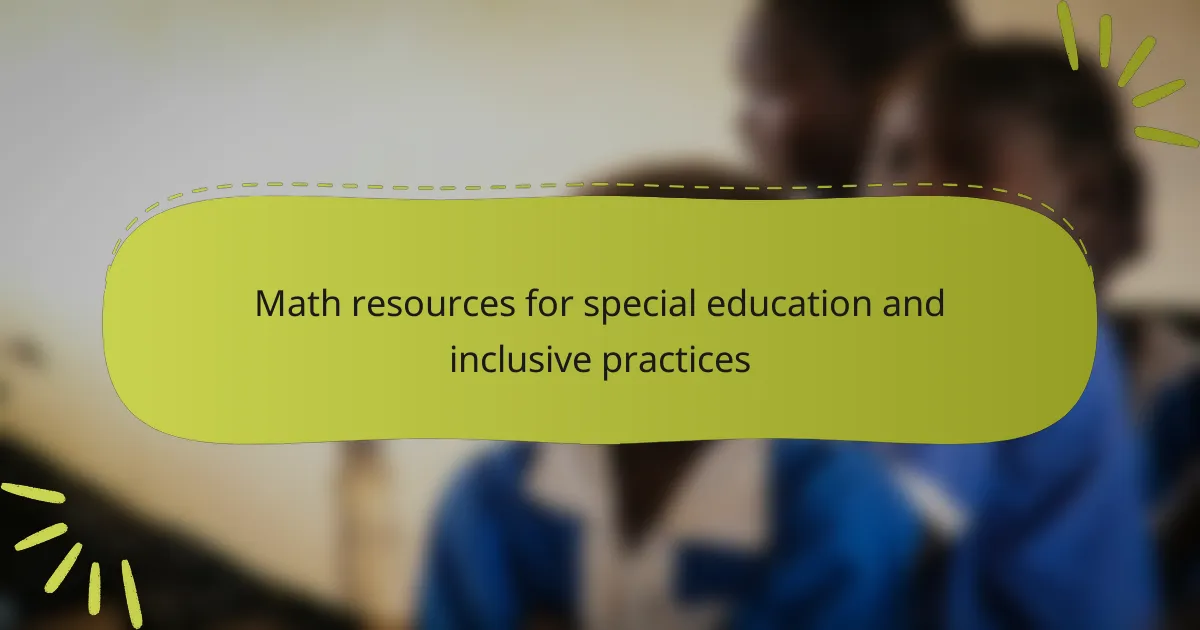Math worksheets are educational tools tailored for varied skill levels, designed to help students practice and reinforce mathematical concepts. These worksheets encompass a spectrum of problems, from basic arithmetic to advanced topics such as algebra and geometry, ensuring that all students can engage meaningfully with the material. They serve dual purposes: assessing student understanding and differentiating instruction to meet individual needs. Research indicates that using differentiated worksheets can enhance student outcomes and engagement in mathematics, making them a vital resource for educators.

What are math worksheets for varied skill levels and assessment?
Math worksheets for varied skill levels and assessment are educational tools designed to help students practice mathematical concepts. They cater to different abilities, ensuring that each student can engage with the material at their level. These worksheets often include a range of problems, from basic arithmetic to advanced topics like algebra and geometry.
The purpose of these worksheets is to assess understanding and reinforce learning. They can be used for formative assessment, allowing teachers to gauge student progress. Varied skill levels in worksheets help in differentiating instruction. This approach ensures that all students, regardless of their proficiency, can benefit from targeted practice.
Research shows that differentiated instruction through tailored worksheets can improve student outcomes in mathematics. A study by Tomlinson (2001) highlights the effectiveness of differentiated tasks in enhancing student engagement and comprehension.
How do math worksheets cater to different skill levels?
Math worksheets cater to different skill levels by offering varying degrees of difficulty and complexity. They include basic exercises for beginners, such as simple addition and subtraction. Intermediate worksheets introduce concepts like multiplication and division. Advanced worksheets challenge students with algebra and geometry problems. Worksheets often incorporate differentiated instruction strategies. This allows teachers to tailor tasks to individual student needs. Additionally, worksheets can provide multiple formats, such as word problems and visual aids. This variety helps engage students with different learning styles. Research shows that differentiated worksheets improve student performance across skill levels.
What are the key attributes of math worksheets for beginners?
Key attributes of math worksheets for beginners include simplicity, clarity, and engagement. Simplicity ensures that problems are easy to understand and solve. Clarity involves using straightforward language and clear instructions. Engagement is achieved through colorful designs and relatable contexts. Worksheets often include visual aids to support learning. They also provide a variety of problem types to reinforce concepts. Additionally, they typically feature progressive difficulty to build confidence. These attributes collectively facilitate effective learning for beginners.
How do worksheets for intermediate learners differ from those for beginners?
Worksheets for intermediate learners focus on more complex concepts compared to those for beginners. Intermediate worksheets often include multi-step problems and critical thinking exercises. They challenge learners to apply their knowledge in varied contexts. In contrast, beginner worksheets emphasize foundational skills and basic operations. Beginners typically practice single-step problems and straightforward calculations. The complexity of language and instructions also increases in intermediate worksheets. This ensures that learners engage with higher-order thinking skills. Additionally, intermediate worksheets may incorporate real-world applications of math concepts. This approach helps bridge the gap between theory and practical use.
What unique features do advanced math worksheets include?
Advanced math worksheets include features such as complex problem sets and real-world application scenarios. They often incorporate higher-order thinking questions that challenge students to analyze and synthesize information. Many worksheets provide step-by-step solutions to enhance understanding. Some include interactive components, such as online quizzes or digital tools for practice. These worksheets may also offer differentiated tasks to cater to various learning styles. Additionally, they often contain enrichment activities for gifted students. Many advanced math worksheets are aligned with curriculum standards to ensure relevance. These features collectively support deeper mathematical comprehension and skill mastery.
Why are assessments included in math worksheets?
Assessments are included in math worksheets to evaluate student understanding and progress. They help identify areas where students excel or struggle. This targeted feedback allows for tailored instruction. Assessments also reinforce learning by encouraging practice and retention. According to educational research, regular assessments can improve student outcomes. The National Center for Education Statistics found that formative assessments significantly enhance learning. Therefore, including assessments in math worksheets supports effective teaching and learning.
How do assessments enhance the learning experience?
Assessments enhance the learning experience by providing feedback on student understanding. They help identify areas where students excel and where they struggle. This targeted feedback allows educators to tailor instruction to meet individual needs. Assessments also promote active engagement in the learning process. When students know they will be assessed, they are more likely to focus on mastering the material. Furthermore, regular assessments can reinforce learning and retention of concepts. Research shows that formative assessments improve student performance by up to 30% (Black & Wiliam, 1998). Overall, assessments are essential tools that drive effective learning and teaching strategies.
What types of assessments are commonly found in math worksheets?
Common types of assessments found in math worksheets include multiple-choice questions, fill-in-the-blank exercises, and word problems. These assessments evaluate understanding of mathematical concepts. Multiple-choice questions test specific knowledge and skills. Fill-in-the-blank exercises assess recall and application abilities. Word problems require critical thinking and problem-solving skills. Additionally, worksheets may include true/false statements and matching exercises. These varied formats cater to different learning styles and skill levels.
What formats do math worksheets come in?
Math worksheets come in various formats. Common formats include printable PDFs, digital documents, and interactive online worksheets. Printable PDFs are widely used for their accessibility and ease of distribution. Digital documents, such as Word files, allow for easy editing and customization. Interactive online worksheets provide instant feedback and can adapt to different skill levels. These formats cater to diverse learning needs and preferences.
How do printable worksheets differ from digital formats?
Printable worksheets are physical copies that users can fill out by hand. Digital formats are electronic files that can be completed on a device. Printable worksheets require printing, while digital formats can be accessed instantly online. Users can customize digital formats easily, whereas printable worksheets have fixed content once printed. Printable worksheets are often used in traditional classroom settings, while digital formats are popular in remote learning environments. Digital formats can include interactive elements, such as quizzes and instant feedback, which are not possible with printable worksheets. The accessibility of digital formats allows for easy sharing and collaboration.
What are the benefits of interactive math worksheets?
Interactive math worksheets enhance student engagement and facilitate personalized learning. They provide immediate feedback, allowing students to understand their mistakes in real-time. This instant feedback can improve retention and comprehension of mathematical concepts. Interactive worksheets often incorporate gamified elements, making learning more enjoyable. They also cater to different learning styles, accommodating visual, auditory, and kinesthetic learners. Research shows that interactive tools can lead to higher motivation levels among students. Studies indicate that students using interactive math resources perform better on assessments compared to traditional methods. Overall, these worksheets support differentiated instruction, making math accessible for varied skill levels.
How can educators effectively use math worksheets for assessment?
Educators can effectively use math worksheets for assessment by aligning them with learning objectives. They should create worksheets that target specific skills and concepts. This allows for a clear evaluation of student understanding. Worksheets can include a variety of question types, such as multiple-choice and open-ended questions. This variety helps assess different levels of comprehension. Additionally, educators can analyze the results to identify areas needing improvement. Regular use of worksheets provides ongoing assessment data. This data can inform instructional decisions and adaptations. Studies show that structured assessments enhance learning outcomes in mathematics.
What strategies can teachers employ to assess student progress using worksheets?
Teachers can employ various strategies to assess student progress using worksheets. One effective strategy is to create differentiated worksheets tailored to diverse skill levels. This allows teachers to gauge individual student understanding. Another strategy is to include a mix of question types, such as multiple-choice, short answer, and problem-solving. This variety helps assess different cognitive skills.
Teachers can also use formative assessments by reviewing completed worksheets in real-time. This immediate feedback helps identify areas needing improvement. Additionally, incorporating self-assessment sections encourages students to reflect on their learning.
Using rubrics for grading worksheets provides clear criteria for student performance. This method enhances transparency and consistency in evaluation. Finally, tracking progress over time through a portfolio of worksheets allows teachers to visualize student growth. These strategies collectively enable effective assessment of student progress in mathematics.
How can worksheets be tailored to meet individual student needs?
Worksheets can be tailored to meet individual student needs by differentiating content based on skill levels. Teachers can assess each student’s current abilities and design worksheets that target specific learning gaps. For example, advanced students may receive challenging problems that require critical thinking. In contrast, students who struggle may need more foundational exercises focusing on basic concepts.
Additionally, incorporating varied formats such as visual aids, manipulatives, or interactive elements can enhance engagement. Customizing the difficulty of problems within the same worksheet allows for scaffolding. This approach ensures that all students can work at their own pace while still being challenged.
Research shows that differentiated instruction improves student outcomes. According to Tomlinson (2001), tailoring educational materials to meet diverse learner needs fosters better understanding and retention.
What are some best practices for creating effective math worksheets?
Effective math worksheets should be clear, engaging, and tailored to the skill levels of students. Use simple language and clear instructions to avoid confusion. Incorporate a variety of question types to cater to different learning styles. Include visual aids, such as diagrams or charts, to enhance understanding. Ensure that the worksheets progressively increase in difficulty to challenge students appropriately. Provide space for students to show their work, which aids in the learning process. Lastly, include answer keys for self-assessment, allowing students to check their understanding. These practices enhance the educational value of math worksheets and support diverse learning needs.
How can educators ensure worksheets are engaging and informative?
Educators can ensure worksheets are engaging and informative by incorporating diverse activities and real-world applications. Engaging worksheets use interactive elements like puzzles, games, and visual aids. Informative content should align with learning objectives and provide clear instructions. Additionally, worksheets can include problems that relate to students’ interests and experiences. Using varied formats, such as multiple-choice, open-ended questions, and collaborative tasks, caters to different learning styles. Research shows that students retain information better when they find the material relevant and enjoyable. For instance, a study by the National Education Association highlights that active learning increases student engagement and comprehension.
What common mistakes should be avoided when designing math worksheets?
Common mistakes when designing math worksheets include lack of clarity in instructions. Clear instructions help students understand tasks better. Overloading worksheets with too many problems can overwhelm students. A balanced number of questions promotes better engagement. Including irrelevant content distracts from the main learning objectives. Focused content enhances learning outcomes. Failing to consider varied skill levels can alienate some students. Worksheets should cater to different abilities for inclusivity. Not providing answer keys can hinder self-assessment. Answer keys support independent learning. Lastly, neglecting visual layout affects readability. A well-structured layout improves comprehension and focus.
How can parents support their children’s learning with math worksheets?
Parents can support their children’s learning with math worksheets by providing guidance and encouragement. They should review the worksheets together to ensure understanding of the concepts. Parents can help children set specific goals for completing each worksheet. This approach fosters a sense of achievement and motivation. Additionally, parents can offer praise for effort and progress. Research indicates that positive reinforcement enhances learning outcomes. Engaging in discussions about problem-solving strategies can promote critical thinking skills. Parents should also create a consistent study routine to establish good habits. This structure can lead to improved performance in mathematics.
What tips can parents use to help children with math worksheets at home?
Parents can help children with math worksheets at home by creating a supportive environment. Establish a quiet space free from distractions. Ensure all necessary materials are readily available. Break down complex problems into smaller, manageable steps. Encourage children to explain their thought process. Use real-life examples to make math relatable. Offer praise for effort, not just correct answers. Monitor progress and adjust difficulty as needed. These strategies enhance understanding and build confidence in math skills.
How can parents assess their child’s understanding through the use of worksheets?
Parents can assess their child’s understanding through the use of worksheets by reviewing their completed work. Worksheets can include a variety of problems that target specific skills. By analyzing the accuracy of responses, parents can identify areas of strength and weakness. For example, correct answers indicate understanding, while incorrect ones may highlight misconceptions. Additionally, parents can observe the time taken to complete tasks. This can provide insight into the child’s confidence and proficiency. Regular assessment through worksheets allows for tracking progress over time. Adjustments to learning strategies can be made based on worksheet performance. This method is backed by educational research indicating that formative assessments improve learning outcomes.
Math worksheets for varied skill levels and assessment are educational resources designed to support students’ mathematical learning by catering to different proficiency levels. These worksheets encompass a range of problems, from basic arithmetic to advanced topics like algebra and geometry, and are used for both practice and assessment of student understanding. Key attributes include simplicity for beginners, increased complexity for intermediate learners, and challenging problem sets for advanced students, along with various formats such as printable and interactive worksheets. Assessments integrated within these worksheets help educators evaluate student progress and tailor instruction to meet individual needs, ultimately enhancing learning outcomes in mathematics.



